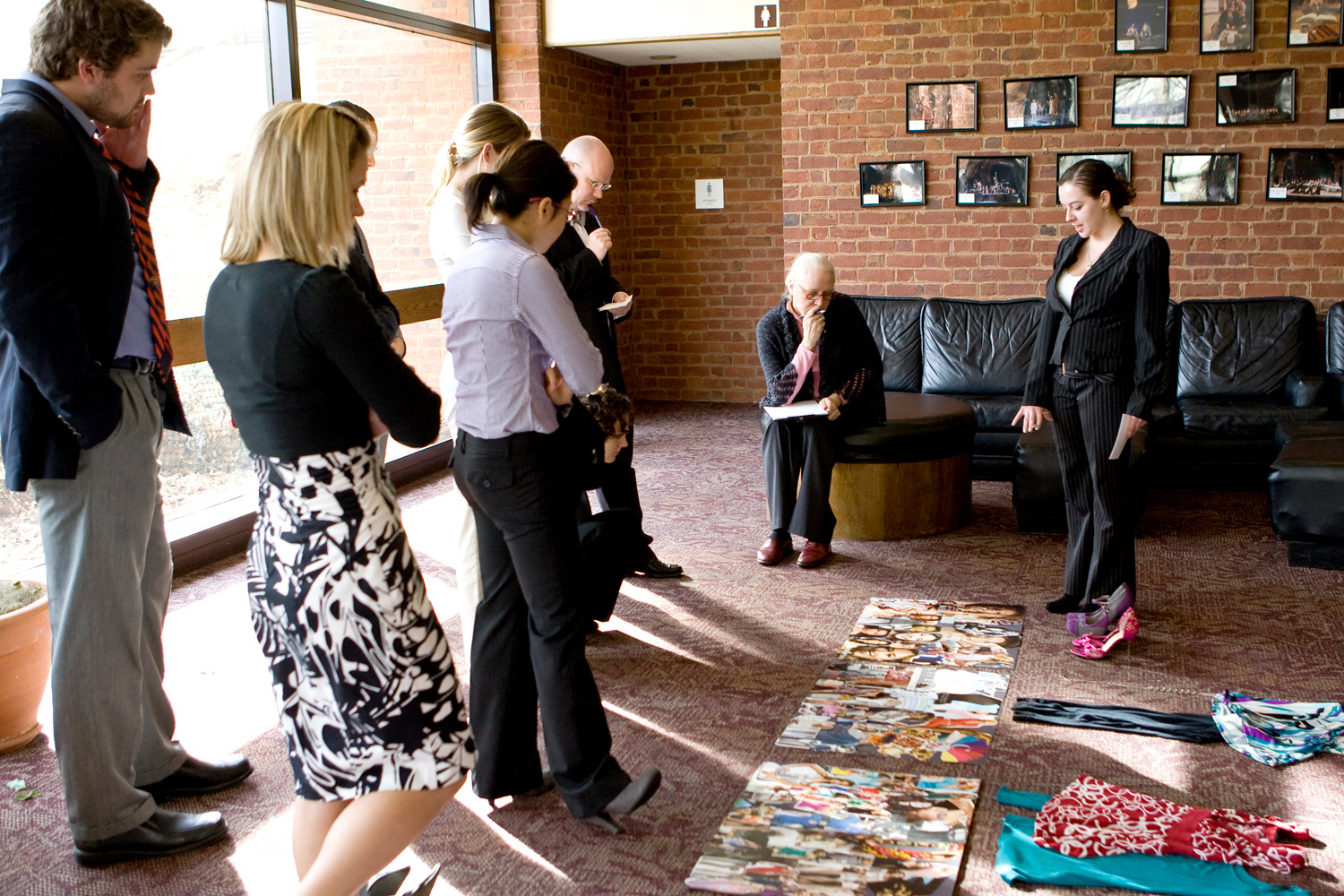January 7, 2009 — Last year, fashion designer Kenneth Cole launched an ad campaign, "We All Walk in Different Shoes." He turned away from the typical models usually featured in clothing advertising and selected independent thinkers from various walks of life to showcase his clothing.
That ad had an influence on University of Virginia architecture student Kendall Nicholson.
"I am very much about the individual and standing out in a crowd," Nicholson said in a presentation to his fellow students in drama professor Gweneth West's January Term class, "The Art of Dress: Conformity and Individuality."
After only two days of class, the 11 students already had applied what they were learning about the psychology and social, economic and political implications of fashion, its impact on our culture, and how much clothing choices reveal about the person.
West then challenged them to consider the numerous external influences that impact their wardrobe choices.
Ron Phillips, fourth-year bachelor of interdisciplinary studies student, talked about his search for perfection and his love of quality in the clothing and accessories he wears. He has a penchant for clothes from designers he described as "fashion forward" — Ralph Lauren, Tom Ford and Calvin Klein. One of his prized possessions is a Gucci watch he said it took him "forever" to save enough money to purchase.
"It was a milestone goal and at 27 years old, still works fine. It tells you about quality," he said.
The conservative, professional look of his wardrobe reflects his job as a mental health worker in a hospital setting, he said. He plans to maintain that professional, conservative look when he enters law school in 2010.
Risa Yangisawa, a fourth-year environmental sciences major, said she is heavily influenced in her choice of clothing by her mother, a former fashion model in Japan who wears what Yangisawa described as "funky" clothes. The exercise made Yangisawa realize she tries to "look different more that she realizes."
The personal fashion biographies the students presented laid the groundwork for their exploration of historical costumes from the Department of Drama's Collection of Historic Dress.
Armed with a crash course in the history of dress, the students will have hands-on access to selected garments from 1830 to 1965 and will work in groups to research the political and sociological affiliations of each. West said the selected garments allow for research into the changing role of women in society, as well as innovations and the pull away from traditions in menswear. Students will analyze the style characteristics of the garments and research the period in both the library and the many stacks of books West brought from her personal home library.
"The garment is a physical manifestation of the period of the wearer," West said.
She went on to describe the court of Louis XIV of France and his manipulation of art and fashion to reflect his agenda. Those who were close to the king "mimicked his dress to show political allegiance," she said.
That ad had an influence on University of Virginia architecture student Kendall Nicholson.
"I am very much about the individual and standing out in a crowd," Nicholson said in a presentation to his fellow students in drama professor Gweneth West's January Term class, "The Art of Dress: Conformity and Individuality."
After only two days of class, the 11 students already had applied what they were learning about the psychology and social, economic and political implications of fashion, its impact on our culture, and how much clothing choices reveal about the person.
West then challenged them to consider the numerous external influences that impact their wardrobe choices.
Ron Phillips, fourth-year bachelor of interdisciplinary studies student, talked about his search for perfection and his love of quality in the clothing and accessories he wears. He has a penchant for clothes from designers he described as "fashion forward" — Ralph Lauren, Tom Ford and Calvin Klein. One of his prized possessions is a Gucci watch he said it took him "forever" to save enough money to purchase.
"It was a milestone goal and at 27 years old, still works fine. It tells you about quality," he said.
The conservative, professional look of his wardrobe reflects his job as a mental health worker in a hospital setting, he said. He plans to maintain that professional, conservative look when he enters law school in 2010.
Risa Yangisawa, a fourth-year environmental sciences major, said she is heavily influenced in her choice of clothing by her mother, a former fashion model in Japan who wears what Yangisawa described as "funky" clothes. The exercise made Yangisawa realize she tries to "look different more that she realizes."
The personal fashion biographies the students presented laid the groundwork for their exploration of historical costumes from the Department of Drama's Collection of Historic Dress.
Armed with a crash course in the history of dress, the students will have hands-on access to selected garments from 1830 to 1965 and will work in groups to research the political and sociological affiliations of each. West said the selected garments allow for research into the changing role of women in society, as well as innovations and the pull away from traditions in menswear. Students will analyze the style characteristics of the garments and research the period in both the library and the many stacks of books West brought from her personal home library.
"The garment is a physical manifestation of the period of the wearer," West said.
She went on to describe the court of Louis XIV of France and his manipulation of art and fashion to reflect his agenda. Those who were close to the king "mimicked his dress to show political allegiance," she said.
Media Contact
Article Information
January 6, 2009
/content/january-term-class-considers-art-dress

